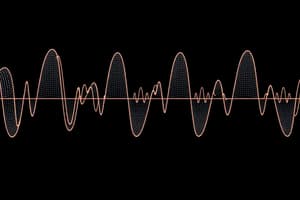Podcast
Questions and Answers
Which of the following is a type of energy that travels through the air and can be heard?
Which of the following is a type of energy that travels through the air and can be heard?
- Heat
- Light
- Electricity
- Sound (correct)
What happens when sound waves reach your ears?
What happens when sound waves reach your ears?
- They make your eardrum vibrate. (correct)
- They make your nose vibrate.
- They make your eyes vibrate.
- They make your mouth vibrate.
What are some things that can make sound?
What are some things that can make sound?
- Animals (correct)
- Trees
- Buildings
- Cars
What happens to your eardrum when sound waves reach it?
What happens to your eardrum when sound waves reach it?
What is a common source of sound?
What is a common source of sound?
What does sound travel through?
What does sound travel through?
Low-frequency sounds are classified as treble.
Low-frequency sounds are classified as treble.
The amplitude of a sound is measured in decibels.
The amplitude of a sound is measured in decibels.
The saxophone produces sound by vibrating a string that is attached to a mouthpiece.
The saxophone produces sound by vibrating a string that is attached to a mouthpiece.
Flashcards
What is Sound?
What is Sound?
A form of energy that moves through the air and is audible.
Eardrum's Response to Sound
Eardrum's Response to Sound
Sound waves cause it to vibrate.
Sound Source: Animals
Sound Source: Animals
Animals create sound through vocalizations and other means.
Eardrum and Sound Waves
Eardrum and Sound Waves
Signup and view all the flashcards
Sound's Medium
Sound's Medium
Signup and view all the flashcards
What is Amplitude?
What is Amplitude?
Signup and view all the flashcards
What Measures Amplitude?
What Measures Amplitude?
Signup and view all the flashcards
Saxophone Sound Source
Saxophone Sound Source
Signup and view all the flashcards
Low-Frequency Sound
Low-Frequency Sound
Signup and view all the flashcards
Study Notes
Sound Energy
- Sound is a type of energy that travels through the air in waves and can be detected by hearing.
Mechanism of Hearing
- When sound waves reach the ears, they create vibrations that are processed by the brain, allowing us to perceive sound.
Sources of Sound
- Common sources of sound include musical instruments, human voices, animal calls, and mechanical devices.
Eardrum Response
- The eardrum vibrates when sound waves hit it, translating these vibrations into auditory signals for the brain.
Sound Travel Medium
- Sound travels through various mediums, including air, water, and solids, with faster speeds in denser materials.
Sound Frequency Classification
- Low-frequency sounds are classified as bass, not treble, which refers to higher frequency sounds.
Measuring Sound Intensity
- The amplitude of a sound, which determines its loudness, is measured in decibels (dB).
Sound Production in Instruments
- The saxophone produces sound through the vibration of a reed, not a string, which is attached to a mouthpiece.
Studying That Suits You
Use AI to generate personalized quizzes and flashcards to suit your learning preferences.




